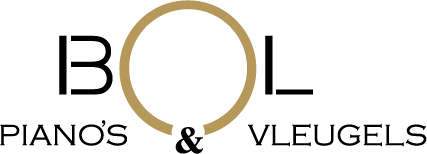
New life in the piano brand Rippen
Johan Jacob Rippen (The Hague, October 1, 1909 – Ede, May 5, 1994) started a piano factory in The Hague with his idiosyncratic design of the Maestro, a straight-string 'upright grand piano'. The success was great and soon he also built conventional pianos. Well-known Rippen piano models were: the Mignon (elegant design), the Carillon (widely sold) and the Studio (intended as an affordable lesson piano). Later, Rippen also produced the Belcanto, Concerto, Cantabile, Romance and the solid oak Largo models.
In 1957 the company moved to the ultra-modern factory on Reehorsterweg in Ede. Unlike traditional traditional piano construction, the instruments at Rippen were built in series. Instead of heavy beams, a light metal self-supporting frame was used. Also innovative was the Permatone soundboard, which was constructed from three layers of spruce wood, making crack formation virtually impossible. The cabinetwork was no longer polished, but finished with modern strong lacquers. Old advertising brochures triumphantly stated: "You can put out a cigarette on it!"
The demand for affordable Rippen pianos was enormous during these years. Exports grew steadily and there were peak years in which 160 employees produced 5,000 instruments. The factory was running at full speed and the instruments were delivered throughout Europe (especially France, Sweden and Germany) using our own trucks. Rippen pianos had a good reputation, especially abroad, because of their solid construction and transparent, clear sound.
In 1962, Rippen worked on the construction of a second factory near Ireland's Shannon Airport. Later, Lindner pianos were built there in large numbers. These pianos consisted largely of plastic parts and were easier and more precise to adjust than traditional pianos. In 1969, the factory complex on Reehorsterweg was sold at a favorable price and then moved to Frankeneng in Ede. However, the company's prosperity subsequently declines for several reasons.
During the move to the Frankeneng, the old factory on the Reehorsterweg (Ede) burned down, resulting in the loss of many machines, molds and supplies. There were also problems in Ireland with the production of the plastic mechanism. The biggest negative factor, however, was the growing import of cheaply produced pianos from Japan and Korea. In 1972, production of the elegant Rippen aluminum grand piano was stopped and the company had to cut back considerably due to stagnant sales. A difficult period followed and until 1975 the company was even in suspension of payments.
Johan Rippen retired in 1976 and in 1978 the tide seemed to turn favorably, but then the recession of 1981 followed. The resulting increasing stocks, combined with the large-scale import of cheap Asian pianos, led to the inevitable bankruptcy in 1985.
Under the leadership of Johan's son, Pieter Rippen , the factory made a new start and its fiftieth anniversary was celebrated in 1987. The Rippen piano factory had built approximately 200,000 instruments at that time (since 1937). Initially, the company crawled out of the valley again and the prospects were reasonably favorable. However, the outbreak of the Gulf War in 1991 was the final blow.
In 1992, the Rippen factory in Ede was closed for good, bringing the curtain down on Dutch piano construction. Rippen has created a total of 217,600 instruments.
For some time now, Bolpiano's has been preparing to revive the Rippen brand. We will keep you informed via our website!
Written by Richard Rijks,
thanks to Pieter Verhulst.



